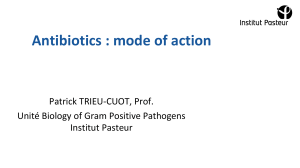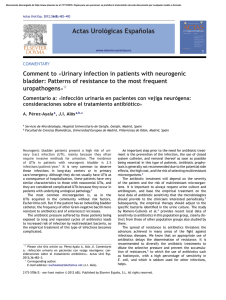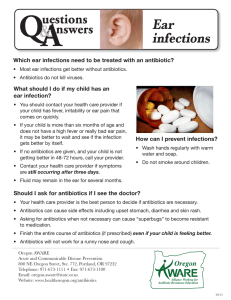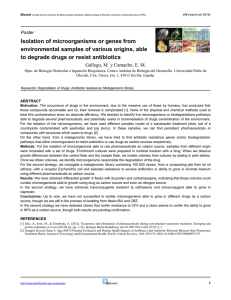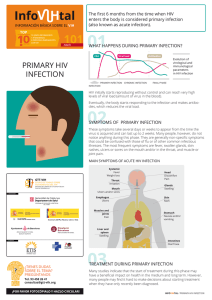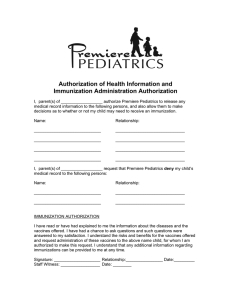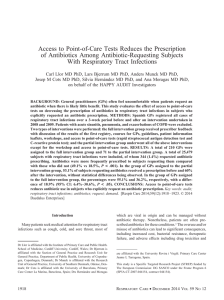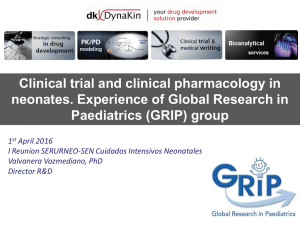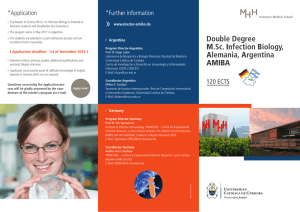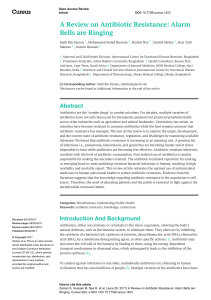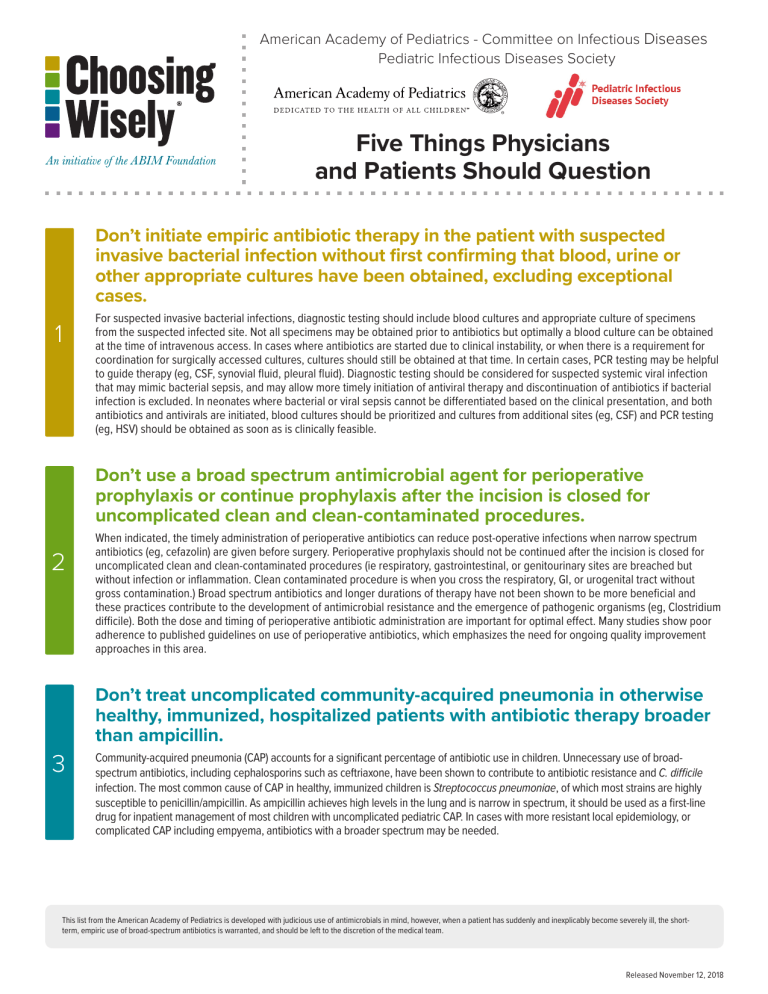
American Academy of Pediatrics - Committee on Infectious Diseases Pediatric Infectious Diseases Society Five Things Physicians and Patients Should Question Don’t initiate empiric antibiotic therapy in the patient with suspected invasive bacterial infection without first confirming that blood, urine or other appropriate cultures have been obtained, excluding exceptional cases. 1 For suspected invasive bacterial infections, diagnostic testing should include blood cultures and appropriate culture of specimens from the suspected infected site. Not all specimens may be obtained prior to antibiotics but optimally a blood culture can be obtained at the time of intravenous access. In cases where antibiotics are started due to clinical instability, or when there is a requirement for coordination for surgically accessed cultures, cultures should still be obtained at that time. In certain cases, PCR testing may be helpful to guide therapy (eg, CSF, synovial fluid, pleural fluid). Diagnostic testing should be considered for suspected systemic viral infection that may mimic bacterial sepsis, and may allow more timely initiation of antiviral therapy and discontinuation of antibiotics if bacterial infection is excluded. In neonates where bacterial or viral sepsis cannot be differentiated based on the clinical presentation, and both antibiotics and antivirals are initiated, blood cultures should be prioritized and cultures from additional sites (eg, CSF) and PCR testing (eg, HSV) should be obtained as soon as is clinically feasible. Don’t use a broad spectrum antimicrobial agent for perioperative prophylaxis or continue prophylaxis after the incision is closed for uncomplicated clean and clean-contaminated procedures. 2 3 When indicated, the timely administration of perioperative antibiotics can reduce post-operative infections when narrow spectrum antibiotics (eg, cefazolin) are given before surgery. Perioperative prophylaxis should not be continued after the incision is closed for uncomplicated clean and clean-contaminated procedures (ie respiratory, gastrointestinal, or genitourinary sites are breached but without infection or inflammation. Clean contaminated procedure is when you cross the respiratory, GI, or urogenital tract without gross contamination.) Broad spectrum antibiotics and longer durations of therapy have not been shown to be more beneficial and these practices contribute to the development of antimicrobial resistance and the emergence of pathogenic organisms (eg, Clostridium difficile). Both the dose and timing of perioperative antibiotic administration are important for optimal effect. Many studies show poor adherence to published guidelines on use of perioperative antibiotics, which emphasizes the need for ongoing quality improvement approaches in this area. Don’t treat uncomplicated community-acquired pneumonia in otherwise healthy, immunized, hospitalized patients with antibiotic therapy broader than ampicillin. Community-acquired pneumonia (CAP) accounts for a significant percentage of antibiotic use in children. Unnecessary use of broadspectrum antibiotics, including cephalosporins such as ceftriaxone, have been shown to contribute to antibiotic resistance and C. difficile infection. The most common cause of CAP in healthy, immunized children is Streptococcus pneumoniae, of which most strains are highly susceptible to penicillin/ampicillin. As ampicillin achieves high levels in the lung and is narrow in spectrum, it should be used as a first-line drug for inpatient management of most children with uncomplicated pediatric CAP. In cases with more resistant local epidemiology, or complicated CAP including empyema, antibiotics with a broader spectrum may be needed. This list from the American Academy of Pediatrics is developed with judicious use of antimicrobials in mind, however, when a patient has suddenly and inexplicably become severely ill, the shortterm, empiric use of broad-spectrum antibiotics is warranted, and should be left to the discretion of the medical team. Released November 12, 2018 4 5 Don’t use vancomycin or carbapenems empirically for neonatal intensive care patients unless an infant is known to have a specific risk for pathogens resistant to narrower-spectrum agents. Antibiotics such as vancomycin and carbapenems are active against highly-antibiotic resistant bacteria unresponsive to other antibiotics. Overuse of these antibiotics can exert selection pressure and promote colonization and infection with increasingly resistant organisms, raising the specter of morbidity and mortality due to untreatable infection. Vancomycin in particular is commonly used as a first-line choice when infection is suspected in the newborn intensive care unit, despite evidence that there is no survival benefit attributed to empiric therapy for most infected infants. Guidelines have been developed that can safely limit the empiric use of vancomycin to those infants known to be colonized with MRSA. Don’t place peripherally inserted central catheters and/or use prolonged IV antibiotics in otherwise healthy children with infections that can be transitioned to an appropriate oral agent. Peripherally inserted central catheters (PICC) are often used for children requiring long-term intravenous antibiotics. The most common infections for which PICCs are placed in children, however, respond well to orally administered antibiotics after a brief course of intravenous therapy. Following hospital discharge, up to 40% of children with PICCs will return to the emergency department with a PICC complication. Studies of children with complicated pneumonia, ruptured appendicitis, and osteomyelitis have demonstrated that, compared with oral conversion prior to hospital discharge, extended intravenous therapy with a PICC does not improve clinical cure rates but is often associated with PICC line complications. How This List Was Created The American Academy of Pediatrics Committee on Infectious Diseases’ Subcommittee on Antimicrobial Resistance and Stewardship identified the need to promote the judicious use of antibiotics in the inpatient setting at their strategic planning session held in October 2015. A workgroup of pediatric experts was formed with representatives from the Academy’s Committee on Infectious Diseases, Committee on Fetus and Newborn, Section on Infectious Diseases, and external partners from the Pediatric Infectious Diseases Society. A modified Delphi process was used to create the list for Choosing Wisely. Experts from the workgroup were asked to create an initial list of what practices may be included– 15 practices for inpatient antimicrobial stewardship were identified through email and conference calls. The workgroup reviewed and ranked via survey which practices within the list of 15 were the most important to include. The survey also asked for any additional suggestions for inpatient AS practices that were not included on the list. This survey was then simultaneously sent to the Antimicrobial Resistance Stewardship workgroup, as well as, internally, to the following Executive Committees: 1. Committee on Hospital Care, 2. Committee on Fetus and Newborn, 3. Committee on Pediatric Emergency Medicine, Section on Critical Care, Section on Emergency Medicine, Section on Infectious Diseases, and Section on Neonatal-Perinatal Medicine and externally to the Pediatric Infectious Diseases Society Executive Committee and their antimicrobial stewardship workgroup. The list was edited based on the feedback received and narrowed down to a new top ten list. The workgroup reviewed the list and voted on their top five based on the following criteria: 1. Feasibility, 2. Supported by Evidence, 3. Not Duplicative, 4. Free from Harm, and 5. Truly Necessary. The list was peer reviewed by relevant expert Committee, Council and Section leadership. The AAP Executive Committee approved this publication of the list. AAP’s disclosure and conflict of interest policy can be found at www.aap.org. This list from the American Academy of Pediatrics is developed with judicious use of antimicrobials in mind, however, when a patient has suddenly and inexplicably become severely ill, the shortterm, empiric use of broad-spectrum antibiotics is warranted, and should be left to the discretion of the medical team. Sources Wong D, Wong T, Romney M, and Leung V. Comparison of outcomes in patients with methicillin-susceptible Staphylococcus aureus (MSSA) bacteremia who are treated with β-lactam vs vancomycin empiric therapy: a retrospective cohort study. BMC Infect Dis. 2016 May 23;16:224. doi: 10.1186/s12879-016-1564-5. 1 Urinary Tract Infection: Clinical Practice Guideline for the Diagnosis and Management of the Initial UTI in Febrile Infants and Children 2 to 24 Months. SUBCOMMITTEE ON URINARY TRACT INFECTION, STEERING COMMITTEE ON QUALITY IMPROVEMENT AND MANAGEMENT. Pediatrics. Aug 2011, peds.2011-1330; DOI: 10.1542/peds.2011-1330. Shah SS, Aronson PL, Mohamad Z, Lorch SA. Delayed acyclovir therapy and death among neonates with herpes simplex virus infection. Pediatrics 2011; 128:1153. Dellinger RP, Levy MM, Rhodes A, et al. Surviving Sepsis Campaign: International guidelines for management of severe sepsis and septic shock: 2012. Critical Care Medicine. 2013 Feb;41(2):580-637. Berrios-Torres S, Umscheid C, Bratzler D, et al. Centers for Disease Control and Prevention Guideline for the Prevention of Surgical Site Infection, 2017. JAMA Surg. doi:10.1001/ jamasurg.2017.0904. Bratzler DW, Dellinger P, Olsen KM et al. Clinical practice guidelines for antimicrobial prophylaxis in surgery. Am J Health Syst Pharm 2013:70:195-283. 2 European Centre for Disease Prevention and Control. Systematic review and evidence-based guidance on perioperative antibiotic prophylaxis. Stockholm: ECDC: 2013. Doi 10.2900/85936. TSteinberg JP, Braun BI, Hellinger WC et al. Timing of antimicrobial prophylaxis and the risk of surgical site infections: results from the Trial to Reduce Antimicrobial Prophylaxis Errors. Ann Surg. 2009;250: 10-6. doi: 10.1097/SLA.0b013e3181ad5fca. Ranji Sr, Shetty K, Posley KA et al. Prevention of Healthcare-Associated Infections. Vol 6 of: Shojania KG, McDonald KM, Wachter RM, Owens DK, editors. Closing the Quality Gap: A Critical Analysis of Quality Improvement Strategies. Technical Review 9 (Prepared by the Stanford University-UCSF Evidence-based Practice Center under Contract No. 290-02-0017). AHRQ Publication No. 04(07)-0051-6. Rockville, MD: Agency for Healthcare Research and Quality. January 2007. Bradley, J. S., Byington, C. L., Shah, S. S., Alverson, B., Carter, E. R., Harrison, C., et al. (2011, October). The management of community-acquired pneumonia in infants and children older than 3 months of age: clinical practice guidelines by the Pediatric Infectious Diseases Society and the Infectious Diseases Society of America. Clinical Infectious Diseases: An Official Publication of the Infectious Diseases Society of America. Oxford University Press. http://doi.org/10.1093/cid/cir531 3 Newman, R. E., Hedican, E. B., Herigon, J. C., Williams, D. D., Williams, A. R., & Newland, J. G. (2012). Impact of a Guideline on Management of Children Hospitalized With Community-Acquired Pneumonia. Pediatrics, 129(3), e597–e604. http://doi.org/10.1542/peds.2011-1533. Harrison CJ, Woods C, Stout G, et al. Susceptibilities of Haemophilus influenzae, Streptococcus pneumoniae, including serotype 19A, and Moraxella catarrhalis paediatric isolates from 2005 to 2007 to commonly used antibiotics. J Antimicrob Chemother 2009; 63:511–9. Kyaw MH, Lynfield R, Schaffner W, et al. Effect of introduction of the pneumococcal conjugate vaccine on drug-resistant Streptococcus pneumoniae. N Engl J Med 2006; 354:1455–63. Hsieh EM, Hornik CP, Clark RH, Laughon MM, Benjamin DK Jr, Smith PB; Best Pharmaceuticals for Children Act—Pediatric Trials Network. Medication use in the neonatal intensive care unit. Am J Perinatol. 2014;31(9):811-821. Ericson JE, Thaden J, Cross HR, Clark RH, Fowler VG Jr, Benjamin DK Jr, Cohen-Wolkowiez M, Hornik CP, Smith PB; Antibacterial Resistance Leadership Group. No survival benefit with empirical vancomycin therapy for coagulase-negative staphylococcal bloodstream infections in infants. Pediatr Infect Dis J. 2015;34(4):371-375. 4 Thaden JT, Ericson JE, Cross H, Bergin SP, Messina JA, Fowler VG Jr, Benjamin DK Jr, Clark RH, Hornik CP, Smith PB; Antibacterial Resistance Leadership Group. Survival Benefit of Empirical Therapy for Staphylococcus aureus Bloodstream Infections in Infants. Pediatr Infect Dis J. 2015;34(11):1175-1179. Chiu CH, Michelow IC, Cronin J, Ringer SA, Ferris TG, Puopolo KM. Effectiveness of a guideline to reduce vancomycin use in the neonatal intensive care unit. Pediatr Infect Dis J. 2011;30(4):273278. Holzmann-Pazgal G, Khan AM, Northrup TF, Domonoske C, Eichenwald EC. Decreasing vancomycin utilization in a neonatal intensive care unit. Am J Infect Control. 2015;43(11):1255-1257. Ruebner R, Keren R, Coffin S et al. Complications of central venous catheters used for the treatment of acute hematogenous osteomyelitis. Pediatrics. 2006 Apr;117(4):1210-5. Kovacich A, Tamma PD, Advani S, et al. Peripherally Inserted Central Venous Catheter Complications in Children Receiving Outpatient Parenteral Antibiotic Therapy (OPAT). Infect Control Hosp Epidemiol. 2016 Apr;37(4):420-4. doi: 10.1017/ice.2015.317. Epub 2016 Jan 12. 5 Keren R, Shah SS, Srivastava R et al. Comparative effectiveness of intravenous vs oral antibiotics for postdischarge treatment of acute osteomyelitis in children. JAMA Pediatr. 2015 Feb;169(2):120-8. doi: 10.1001/jamapediatrics.2014.2822. Rangel SJ, Anderson BR, Srivastava R, et al. Intravenous Versus Oral Antibiotics for the Prevention of Treatment Failure in Children With Complicated Appendicitis: Has the Abandonment of Peripherally Inserted Catheters Been Justified? Ann Surg. 2016 Jul 15. [Epub ahead of print] Shah SS, Srivastava R, Wu S, et al. Intravenous Versus Oral Antibiotics for Postdischarge Treatment of Complicated Pneumonia. Pediatrics. 2016 Dec;138(6). pii: e20161692. Epub 2016 Nov 17. About the ABIM Foundation About the American Academy of Pediatrics The mission of the ABIM Foundation is to advance medical professionalism to improve the health care system. We achieve this by collaborating with physicians and physician leaders, medical trainees, health care delivery systems, payers, policymakers, consumer organizations and patients to foster a shared understanding of professionalism and how they can adopt the tenets of professionalism in practice. The American Academy of Pediatrics is an organization of 68,000 primary care pediatricians, pediatric medical subspecialists and pediatric surgical specialists dedicated to the health, safety and well-being of infants, children, adolescents and young adults. ® About the Pediatric Infectious Diseases Society The Pediatric Infectious Diseases Society is a notfor-profit professional organization of over 1,200 pediatric infectious diseases experts. Its members are leaders across the global scientific and public health spectrum, including clinical care, advocacy, academics, government, and the pharmaceutical industry. From fellowship training to continuing medical education, research, regulatory issues and guideline development, PIDS members are the core professionals advocating for the improved health of children with infectious diseases both nationally and around the world, participating in critical public health and medical professional advisory committees that determine the treatment and prevention of infectious diseases, immunization practices in children, and the education of pediatricians. For more information, visit http://www.pids.org. For more information or to see other lists of Things Clinicians and Patients Should Question, visit www.choosingwisely.org.
